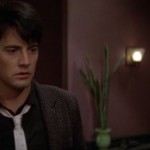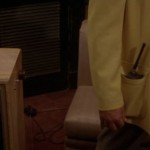The Blue Velvet Project
-
The Blue Velvet Project, #144

Second #6768, 112:48 Fragments: 1. Frank’s back to the camera. 2. Dorothy’s apartment stretched out in horizontal like a widescreen nightmare. 3. The vintage fridge, solid. 4. The black circle mirror above the bathroom pedestal sink. (If Roberto Bolaño had done the set design for Blue Velvet, the mirror would have been inscrutably evil.) 5. The silencer, attached. 6. The sconce on the wall above the couch, looking at first glance, in its isolated away, like the screaming mouth on Jeffrey’s wall. 7. The sadness of Dorothy’s husband’s dead paunch. 8. Frank’s death in under two minutes, uncertain at this […]
by Nicholas Rombes on Jul 27, 2012 -
The Blue Velvet Project, #143

Second #6721, 112:01 In an essay from 1929, “The Filmic Fourth Dimension,” Sergei Eisenstein wrote about the impossibility of “the single-meaningness” of the film frame, which “can never be an inflexible letter of the alphabet, but must always remain a multiple-meaning ideogram.” And part of the frame’s meaning lies outside of the frame itself, in the implied off-screen space that surrounds it, accumulated in fragments from places the film has already taken us. In the frame above, Jeffrey is in Dorothy’s bedroom, laying his trap for Frank, whom he knows is listening as he reveals his false location to Detective […]
by Nicholas Rombes on Jul 25, 2012 -
The Blue Velvet Project, #142

Second #6674, 111:14 The seemingly insignificant, glimpsed, unremembered moments of a film revealed in the details of a random frame. In this case, Jeffrey’s watch, fleetingly illuminated as he retraces his steps back up to Dorothy’s apartment, in flight from the Well-Dressed Man. The importance of the watch may be the very fact of its unimportance—it has no significance in terms of the plot. And yet, it is a part of the film; it constitutes an element of Blue Velvet’s image-archive. The frames come from a compressed sequence made up of 17 shots that, in less than a minute of […]
by Nicholas Rombes on Jul 23, 2012 -
The Blue Velvet Project, #141

Second #6627, 110:27 In one of Blue Velvet’s most unsettling moments, Jeffrey, on his way out of Dorothy’s carnaged apartment, sees the Well-Dressed Man coming towards the building in the night. Like some figure from a dream, he approaches, his police radio crackling. At this point, neither Jeffrey nor the audience knows, at least with any certainty, that the Well-Dressed Man is in fact Frank. In his essay “The Uncanny” (1919) Freud wrote that it is only this factor of involuntary repetition which surrounds with an uncanny atmosphere what would otherwise be innocent enough, and forces upon us the idea […]
by Nicholas Rombes on Jul 20, 2012 -
The Blue Velvet Project, #140

“I’m gonna let them find you on their own,” Jeffrey quietly says to himself, invoking Frank, who will appear again in a few minutes. Turning away from the camera, his ear might actually hear the song on the soundtrack, Ketty Lester’s version of “Love Letters,” released as a single in 1961: [jwplayer mediaid=”48654″] The song was written in 1945 by Victor Young and Edward Heyman, and appeared in the film Love Letters, which starred Jennifer Jones and Joseph Cotten. Adapted by none other than Ayn Rand (“People should be able to build what they want to build, when they want […]
by Nicholas Rombes on Jul 18, 2012 -
The Blue Velvet Project, #139

Second #6533, 108:53 1. Jeffrey’s reaction to the violence that has happened in Dorothy’s apartment shifts gradually in the moments that follow this shot from numbed horror to sorrow, as if what he sees before him (Dorothy’s husband and the Yellow Man, tortured and dead or dying) is in some sense the awful answer to his curiosity. 2. From Charles Musser’s The Emergence of Cinema: The American Screen to 1907: Sex and violence figured prominently in American motion pictures from the outset. In fact, such subjects were consistent with the individualized, peephole nature of the viewing experience: they showed amusements […]
by Nicholas Rombes on Jul 16, 2012 -
The Blue Velvet Project, #138

Second #6486, 108:06 Inside Dorothy’s apartment Jeffrey surveys the carnage. The television set, its screen cracked. Detective Gordon, the Man in Yellow, somewhere in between dead and alive, and perhaps, at the outer edges of possibility, hooked up to the television. Lynch has talked about his desire to make a painting that “would really be able to move” as a motivation for making his first films, and during the apartment scene the screen does indeed become like a canvas, its objects staged and still, with occasional movement, some fevered dream of an automated wax-museum. Is Blue Velvet an avant-garde film? […]
by Nicholas Rombes on Jul 13, 2012 -
The Blue Velvet Project, #137

Second #6439, 107:19 Jeffrey is about to enter Dorothy’s apartment where he’ll find a hellish scene of Frank’s human butchery. The frame captures his vulnerability, his exposed back to the implied danger of the frame’s open space. The red light at the end of the hall, the sharp-edged shadow across the far door, the tar-pit black hallway floor, and the faint ringing noise on the soundtrack, like something deeply broken in the building itself, all conspire to create a feeling that verges on existential terror. In the pan and scan 1987 VHS version (the photo below is of the film […]
by Nicholas Rombes on Jul 11, 2012 -
The Blue Velvet Project, #136

Second #6392, 106:32 If you’re of a certain age, you first saw Blue Velvet on VHS (Karl-Lorimar Video) in 1987, in its over-saturated, pan and scan version, which eliminated nearly 40% of the framed image (below). This is Sandy in her father’s home office, on the phone to the police station, trying desperately to reach her father to safeguard Jeffrey, who is on his way to Dorothy’s apartment. “We don’t know his whereabouts at this time,” the voice tells her from the other end of the line. In the VHS version, Sandy is psychedelic, illuminating the screen with her desire. […]
by Nicholas Rombes on Jul 9, 2012 -
The Blue Velvet Project, #135

Second #6345, 105:45 Sandy, in her room, on the phone with Jeffrey after the naked, bruised, Dorothy has just revealed—in front of Jeffrey, Sandy, and Mrs. Williams—that Jeffrey “put his disease” in her. This frame comes from a shot that lasts just under one minute and that is so completely and dramatically sincere as to give lie to the notion that Blue Velvet is somehow a parody or an instance of postmodern Camp. Sandy’s question to herself when she gets off the phone with Jeffrey—“Where is my dream?”—offers a momentary gap in the film. For if most of the time […]
by Nicholas Rombes on Jul 6, 2012










